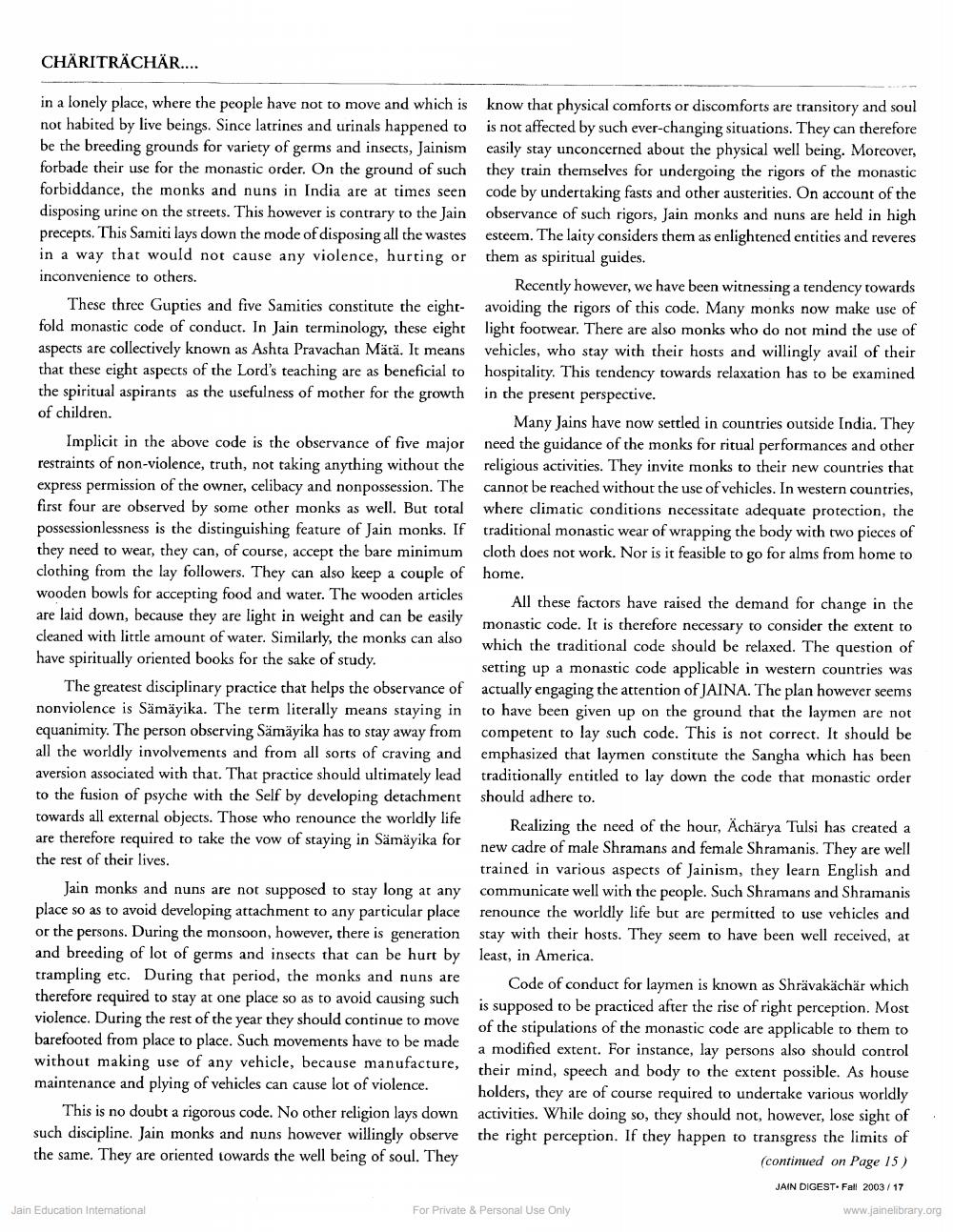________________
CHÄRITRÄCHÄR....
in a lonely place, where the people have not to move and which is not habited by live beings. Since latrines and urinals happened to be the breeding grounds for variety of germs and insects, Jainism forbade their use for the monastic order. On the ground of such forbiddance, the monks and nuns in India are at times seen disposing urine on the streets. This however is contrary to the Jain precepts. This Samiti lays down the mode of disposing all the wastes in a way that would not cause any violence, hurting or inconvenience to others.
These three Gupties and five Samities constitute the eightfold monastic code of conduct. In Jain terminology, these eight aspects are collectively known as Ashta Pravachan Mätä. It means that these eight aspects of the Lord's teaching are as beneficial to the spiritual aspirants as the usefulness of mother for the growth of children.
Implicit in the above code is the observance of five major restraints of non-violence, truth, not taking anything without the express permission of the owner, celibacy and nonpossession. The first four are observed by some other monks as well. But total possessionlessness is the distinguishing feature of Jain monks. If they need to wear, they can, of course, accept the bare minimum clothing from the lay followers. They can also keep a couple of wooden bowls for accepting food and water. The wooden articles are laid down, because they are light in weight and can be easily cleaned with little amount of water. Similarly, the monks can also have spiritually oriented books for the sake of study.
The greatest disciplinary practice that helps the observance of nonviolence is Sämäyika. The term literally means staying in equanimity. The person observing Sämäyika has to stay away from all the worldly involvements and from all sorts of craving and aversion associated with that. That practice should ultimately lead to the fusion of psyche with the Self by developing detachment towards all external objects. Those who renounce the worldly life are therefore required to take the vow of staying in Sämäyika for
the rest of their lives.
Jain monks and nuns are not supposed to stay long at any place so as to avoid developing attachment to any particular place or the persons. During the monsoon, however, there is generation and breeding of lot of germs and insects that can be hurt by trampling etc. During that period, the monks and nuns are therefore required to stay at one place so as to avoid causing such violence. During the rest of the year they should continue to move barefooted from place to place. Such movements have to be made without making use of any vehicle, because manufacture, maintenance and plying of vehicles can cause lot of violence.
This is no doubt a rigorous code. No other religion lays down such discipline. Jain monks and nuns however willingly observe the same. They are oriented towards the well being of soul. They
Jain Education International
know that physical comforts or discomforts are transitory and soul is not affected by such ever-changing situations. They can therefore easily stay unconcerned about the physical well being. Moreover, they train themselves for undergoing the rigors of the monastic code by undertaking fasts and other austerities. On account of the observance of such rigors, Jain monks and nuns are held in high esteem. The laity considers them as enlightened entities and reveres them as spiritual guides.
Recently however, we have been witnessing a tendency towards avoiding the rigors of this code. Many monks now make use of light footwear. There are also monks who do not mind the use of vehicles, who stay with their hosts and willingly avail of their hospitality. This tendency towards relaxation has to be examined in the present perspective.
Many Jains have now settled in countries outside India. They need the guidance of the monks for ritual performances and other religious activities. They invite monks to their new countries that cannot be reached without the use of vehicles. In western countries, where climatic conditions necessitate adequate protection, the traditional monastic wear of wrapping the body with two pieces of cloth does not work. Nor is it feasible to go for alms from home to home.
All these factors have raised the demand for change in the monastic code. It is therefore necessary to consider the extent to which the traditional code should be relaxed. The question of setting up a monastic code applicable in western countries was actually engaging the attention of JAINA. The plan however seems to have been given up on the ground that the laymen are not competent to lay such code. This is not correct. It should be emphasized that laymen constitute the Sangha which has been traditionally entitled to lay down the code that monastic order should adhere to.
Realizing the need of the hour, Ächärya Tulsi has created a new cadre of male Shramans and female Shramanis. They are well trained in various aspects of Jainism, they learn English and communicate well with the people. Such Shramans and Shramanis renounce the worldly life but are permitted to use vehicles and stay with their hosts. They seem to have been well received, at least, in America.
Code of conduct for laymen is known as Shrävakächär which is supposed to be practiced after the rise of right perception. Most of the stipulations of the monastic code are applicable to them to a modified extent. For instance, lay persons also should control their mind, speech and body to the extent possible. As house holders, they are of course required to undertake various worldly activities. While doing so, they should not, however, lose sight of the right perception. If they happen to transgress the limits of (continued on Page 15)
JAIN DIGEST-Fall 2003/17 www.jainelibrary.org
For Private & Personal Use Only




